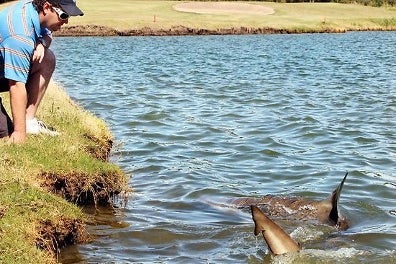Ask your favorite shark-obsessed 8-year-old for a fun fact, and the odds are good that they’ll tell you that bull sharks can live in the ocean or in fresh water. Dozens of shark species can briefly enter brackish or fresh water, and Glyphis, more commonly known as the river shark, spends almost its whole life in fresh water. But the ability to happily take up residence in one kind of environment or the other, salty or not, is rare among fish.
Osmosis—the tendency of water to flow from an environment with less salt to one with more—means that water is removed more quickly from an animal’s cells in the ocean than it is in other environments. Species that evolved to handle this pressure typically don’t do well in lakes.
The fascinating physiological ability to handle different osmotic circumstances has allowed bull sharks to travel to some interesting places. They’ve been seen as far up the Mississippi River as Illinois, as well as hundreds of miles up the Amazon. However, they’re still typically found in coastal waters; it was unknown exactly how long they could take up residence in bodies of water that are firmly inland. Now we have something of an answer. According to research published this summer in the journal Marine and Fishery Sciences, a population of bull sharks survived in fresh water for at least 17 years. Their home: an Australian golf course’s water hazard.
During the 1990s, several major flooding events connected the golf course’s ponds with the nearby Logan and Albert rivers, which, at about 50 miles from the ocean, are known to be bull shark nursery areas. Soon after, golfers began to report several unusual sightings. “They saw fins in the water,” said the study’s author, Peter Gausmann of Germany’s Ruhr University Bochum. “At first they didn’t believe it, and people thought it was a mistake or a myth. But sightings just kept coming!” Apparently, some sharks had swum in, and after the floodwaters receded, they were left behind.
Although this species had never been seen in an environment quite like this one before, experts weren’t surprised to learn that they can thrive in golf course water features. “I find the versatility of the bull shark, and their diverse use of habitats, absolutely fascinating,” Amy Smoothey, a shark scientist working at New South Wales’ Department of Primary Industries in Australia, told me. “As juveniles, they grow up in rivers and estuaries and stay there for up to five years, while larger and older sharks move into coastal and offshore areas. Bull sharks link rivers, nearshore beaches, and offshore reefs. They can travel over 2,000 kilometers in one direction as part of their seasonal migrations.”

The golf course owners embraced their new residents and advertised a once-in-a-lifetime chance to play golf with sharks. “While the sharks were surviving on their own, the golf course managers started to feed them to get them to come closer to shore, where golfers could see them,” Gausmann said. “The golf course owners and guests started to develop a positive relationship towards the sharks as something interesting and unusual, which is great because this species can sometimes have a bad reputation.”
This sort of attitude isn’t surprising, according to Tom Metzger, the director of golf operations at the Vineyards Country Club in Naples, Florida, where my parents are members. He told me that some tourists love to see large alligators on golf courses. “We’re in their territory; they can just walk on out of the Everglades and right into the country clubs. Some people even try to stick their hands into the water, trying to get their $3 ball back … and I wouldn’t recommend doing that.”
Sometime around 2015, sightings of the golf course sharks stopped entirely. Gausmann doesn’t know what happened to them, but the most likely explanation, he says, is that they were killed by illegal fishing. Nothing else had changed in the environment they had been thriving in for so long, and their growing legend may have attracted trophy hunters. Or they may have accidentally been caught by anglers who were illegally fishing for other residents of the lake. This is, tragically, not an uncommon fate for sharks. Each year, countless millions die from harmful fishing practices.
It’s hard to pinpoint exactly how long the sharks lived on the golf course, because there were several different flooding events in the early 1990s and no one is sure exactly when they disappeared. But they were seen regularly from 1996 to 2013, for over 17 years, and that’s firmly a record for how long bull sharks can survive in fresh water. “This new publication highlights their impressive adaptability to a wide variety of environments,” Smoothey told me.
Although these golf course sharks were known among internet factoid enthusiasts and extreme golfers for years, Gausmann’s study, part of an overall biogeography study attempting to determine the limits of where different marine animals can survive, gathered enough hard evidence to prove that the amazing story of sharks on a golf course is genuine. It shows that while people often think of wildlife habitat as being far from humans, large animals can often be found right in our backyards—and that we have to be careful of how we interact with the environment. In the end, despite the toothsome creatures’ fearsome reputation, it was humans that did the sharks in.
